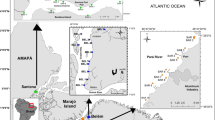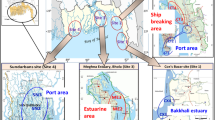Abstract
Ustica is an island relatively far from continental, industrial and urban settlements and it has been designated as a marine protected area with the aim of preserving the natural diversity of flora and fauna of the surrounding sea. In such an environment, the assessment of the levels and origin of persistent organic pollutants such as polycyclic aromatic hydrocarbons (PAHs) can shed light on the mechanisms and effects of pollutant long-distance transport in the western Mediterranean Sea. PAHs concentrations resulted relatively low when compared with those of other coastal areas of the Mediterranean Sea. The low values of the ratio between low- and high-molecular-weight (LMW and HMW, respectively) PAHs and the fluoranthene and pyrene ratios underlined a pyrolytic origin of these contaminants. The prevalence of HMW-PAHs, however, may also be due to the effect of LMW-PAH preferential degradation during transport and burial into sediments. On the other hand, petrogenic sources prevailed in the past. Whilst PAHs concentrations showed a recent increase, especially at the site close to the port, the estimated sedimentary fluxes of PAHs ranged from 0.5 to 25 μg m−2 year−1.



Similar content being viewed by others
References
Aboul-Kassim, T. A. T., & Simoneit, B. R. T. (1995). Petroleum hydrocarbon fingerprinting and sediment transport assessed by molecular biomarker and multivariate statistical analyses in the eastern harbour of Alexandria, Egypt. Marine Pollution Bulletin, 30, 63–73. doi:10.1016/0025-326X(94)00102-F.
Abrajano, T. A., Yan, B., & O’Malley, V. (2003). High molecular weight petrogenic and pyrogenic hydrocarbons in aquatic environments. In B. Sherwood Lollar (Ed.), Environmental geochemistry, treatise on geochemistry (vol. 9, pp. 475–509). Elsevier.
Baumard, P., Budzinski, H., & Garrigues, P. (1998). Polyciclic aromatic hydrocarbons in sediments and mussels of the western Mediterranean Sea. Environmental Toxicology and Chemistry, 17, 765–776. doi:10.1897/1551-5028(1998)017<0765:PAHISA>2.3.CO;2.
Behymer, T. D., & Hites, R. A. (1988). Photolysis of polycyclic aromatic hydrocarbons adsorbed on fly ash. Environmental Science & Technology, 22, 1311–1319. doi:10.1021/es00176a011.
Bellucci, L. G., Frignani, M., Cochran, J. K., Albertazzi, S., Collavini, F., Cecconi, R., et al. (2007). 210Pb and 137Cs as chronometers for salt marsh accretion in the Venice Lagoon—links to flooding frequency and climate change. Journal of Environmental Radioactivity, 97, 85–102. doi:10.1016/j.jenvrad.2007.03.005.
Benlahcen, K. T., Chaoui, A., Budzinski, H., Bellocq, J., & Garrigues, P. H. (1997). Distribution and sources of polycyclic aromatic hydrocarbons in some Mediterranean coastal sediments. Marine Pollution Bulletin, 34(5), 298–305. doi:10.1016/S0025-326X(96)00098-7.
Bouloubassi, I., & Saliot, A. (1993). Investigation of anthropogenic and natural organic inputs in estuarine sediments using hydrocarbon markers (NAH, LAB, PAH). Oceanologica Acta, 16(2), 145–161.
Bouloubassi, I., Méjanelle, L., Pete, R., Fillaux, J., Lorre, A., & Point, V. (2006). Transport by sinking particles in the open Mediterranean Sea: a 1 year sediment trap study. Marine Pollution Bulletin, 52, 560–571. doi:10.1016/j.marpolbul.2005.10.003.
Budzinski, H., Jones, I., Bellocq, J., Pierrad, C., & Garrigues, P. (1997). Evaluation of sediment contamination by polycyclic aromatic hydrocarbons in the Gironde estuary. Marine Chemistry, 58, 85–97. doi:10.1016/S0304-4203(97)00028-5.
Cacho, I., Grimalt, J. O., Sierro, F. J., Shackleton, N., & Canals, M. (2000). Evidence for enhanced Mediterranean thermohaline circulation during rapid climatic coolings. Earth and Planetary Science Letters, 183, 417–429. doi:10.1016/S0012-821X(00)00296-X.
Chester, R. (2000). Marine geochemistry. Bodmin, Cornwall, UK: Blackwell Science, 520 pp.
Dachs, J., Bayona, J. M., Fowler, S. W., Miquel, J.-C., & Albaigés, J. (1996). Vertical fluxes of polycyclic aromatic hydrocarbons and organochlorine compounds in the western Alboran Sea (soutwestern Mediterranean). Marine Chemistry, 52, 75–86.
Fowler, S. W., & Knauer, G. A. (1986). Role of large particles in the transport of elements and organic compounds through the oceanic water column. Progress in Oceanography, 16, 147–194. doi:10.1016/0079-6611(86)90032-7.
Frignani, M., Langone, L., Albertazzi, S., & Ravaioli, M. (1993). Cronologia di sedimenti marini—analisi di 210Pb via 210Po per spettrometria alfa. Technical Report 28, CNR-IGM, Bologna, 24 pp. (In Italian)
Frignani, M., Sorgente, D., Langone, L., Albertazzi, S., & Ravaioli, M. (2004). Behaviour of Chernobyl radiocesium in sediments of the Adriatic sea off the Po River delta and the Emilia-Romagna coast. Journal of Environmental Radioactivity, 71, 299–312. doi:10.1016/S0265-931X(03)00175-9.
Giani, M., Boldrin, A., Matteucci, G., Frascari, F., Gismondi, M., & Rabitti, S. (2001). Downward fluxes of particulate carbon, nitrogen and phosphorus in the North Western Adriatic sea. The Science of the Total Environment, 266, 125–134. doi:10.1016/S0048-9697(00)00744-0.
Gogou, A., Bouloubassi, I., & Stephanou, E. G. (2000). Marine organic geochemistry of the Eastern Mediterranean: aliphatic and polyaromatic hydrocarbons in Cretan Sea surficial sediments. Marine Chemistry, 68, 265–282.
Grimmer, G., & Bohnke, H. (1975). Polycyclic aromatic hydrocarbon profile analysis of hifh protein foods, oils and fats by gaschromatography. Journal of the Association of Official Analytical Chemists, 58, 725–729.
Lipiatou, E., & Saliot, A. (1991). Hydrocarbon contamination of the Rhone delta and the open western Mediterranean. Marine Pollution Bulletin, 22, 297–304. doi:10.1016/0025-326X(91)90808-6.
Lipiatou, E., Tolosa, I., Simò, R., Bouloubassi, I., Dachs, J., Marti, S., et al. (1997). Mass budget and dynamics of polycyclic aromatic hydrocarbons in the Mediterranean Sea. Deep-Sea Research. Part II, Topical Studies in Oceanography, 44, 881–905. doi:10.1016/S0967-0645(96)00093-8.
Marsili, L., Caruso, A., Fossi, C., Zanardelli, M., Politi, E., & Focardi, S. (2001). Polycyclic aromatic hydrocarbons (PAHs) in subcutaneous biopsies of Mediterranean cetaceans. Chemosphere, 44, 147–154. doi:10.1016/S0045-6535(00)00206-X.
Mastral, A. M., Callén, M. S., López, J. M., Murillo, R., García, T., & Navarro, M. V. (2003). Critical review on atmospheric PAH. Assessment of reported data in the Mediterranean basin. Fuel Processing Technology, 80, 183–193. doi:10.1016/S0378-3820(02)00249-7.
Nieuwenhuize, J., Maas, Y. E. M., & Middelburg, J. J. (1994). Rapid analysis of organic carbon and nitrogen in particulate materials. Marine Chemistry, 45, 217–224. doi:10.1016/0304-4203(94)90005-1.
Pavoni, B., Mecozzi, M., Berto, D., Ausili, A., Romano, E., Amici, M., et al. (2001). Environmental pollutants and organic carbon content in sediments from an area of the Moroccan Mediterranean coast. Toxicological and Environmental Chemistry, 84, 53–67.
Poulain, P. M., & Zambianchi, E. (2007). Surface circulation in the central Mediterranean Sea as deduced from Lagrangian drifters in the 1990s. Continental Shelf Research, 27, 981–1001. doi:10.1016/j.csr.2007.01.005.
Raoux, C., Bayona, J. M., Miquel, J. C., Teyssie, J. L., Fowler, S. W., & Labaiés, J. (1999). Particulate fluxes of aliphatic and aromatic hydrocarbons in near shore waters to the north-western Mediterranean Sea, and the effect of continental runoff. Estuarine, Coastal and Shelf Science, 48, 605–616. doi:10.1006/ecss.1998.0458.
Robbins, J. A. (1978). Geochemical and geophysical application of radioactive lead. In J. O. Nriagu (Ed.), Biogeochemistry of lead in the environment (pp. 332–367). Amsterdam: Elsevier.
Sakai, H., Kojima, Y., & Saito, K. (1986). Distribution of heavy metals in water and sieved sediment in the Toyohira River. Water Research, 20, 559–567. doi:10.1016/0043-1354(86)90019-9.
Shepard, F. P. (1954). Nomenclature based on sand–silt–clay ratios. Journal of Sedimentary Petrology, 24, 151–158.
Sicre, M. A., Marty, J. C., Saliot, A., Aparicio, X., Grimalt, J., & Albaiges, J. (1987). Aliphatic and aromatic hydrocarbons in different sized aerosols over the Mediterranean Sea: occurrence and origin. Atmospheric Environment, 21, 2247–2259. doi:10.1016/0004-6981(87)90356-8.
Simo, R., Grimalt, J. O., & Albaiges, J. (1997). Loss of unburned-fuel hydrocarbons from combustion aereosol during atmospheric transport. Environmental Science & Technology, 31, 2697–2700. doi:10.1021/es960994m.
Tolosa, I., Bayona, J. M., & Albaigés, J. (1996). Aliphatic and polycyclic aromatic hydrocarbons and sulfur/oxygen derivatives in northwestern Mediterranean sediments: spatial and temporal variability, fluxes, and budgets. Environmental Science & Technology, 30(8), 2495–2503. doi:10.1021/es950647x.
UNEP (United Nations Environment Programme Chemicals). (2002). Mediterranean regional report. Regionally based assessment of persistent toxic substances.
White, K. L. (1986). An overview of immunotoxicology and carcinogenic polycyclic aromatic hydrocarbons. Environmental Carcinology Reviews, 2, 163–202.
Youngblood, W. W., & Blumer, M. (1975). Polycyclic aromatic hydrocarbons in the environment: homologous series in soils and recent marine sediments. Geochimica et Cosmochimica, A39, 1303–1314. doi:10.1016/0016-7037(75)90137-4.
Zaghden, H., Kallel, M., Elleuch, B., Oudot, J., & Saliot, A. (2007). Sources and distribution of aliphatic and polyaromatic hydrocarbons in sediments of Sfax, Tunisia, Mediterranean Sea. Marine Chemistry, 105, 70–89. doi:10.1016/j.marchem.2006.12.016.
Acknowledgements
The research was realised with the financial support of the Natural Marine Reserve of the island of Ustica. The authors wish to thank Fabio Savelli, V. Zangrando and G. Franceschini for the technical and graphic assistance and the crew of R/V Astrea for the assistance during sampling.
Author information
Authors and Affiliations
Corresponding author
Rights and permissions
About this article
Cite this article
Berto, D., Cacciatore, F., Ausili, A. et al. Polycyclic Aromatic Hydrocarbons (PAHs) from Diffuse Sources in Coastal Sediments of a Not Industrialised Mediterranean Island. Water Air Soil Pollut 200, 199–209 (2009). https://doi.org/10.1007/s11270-008-9904-8
Received:
Accepted:
Published:
Issue Date:
DOI: https://doi.org/10.1007/s11270-008-9904-8




